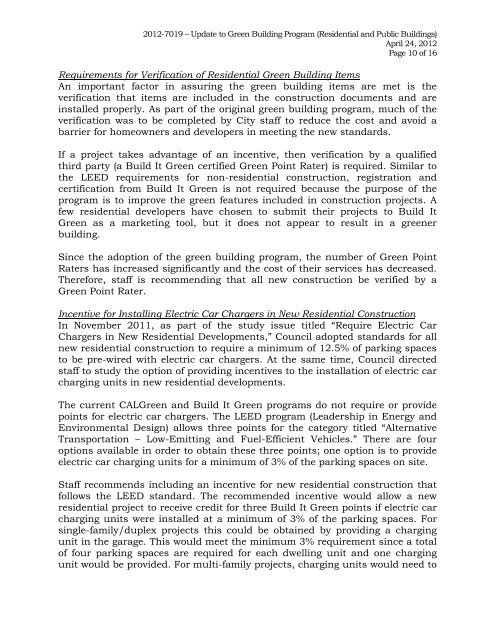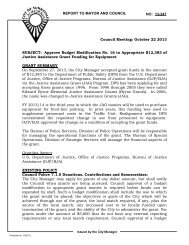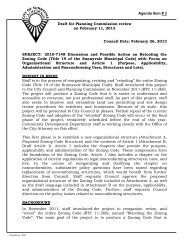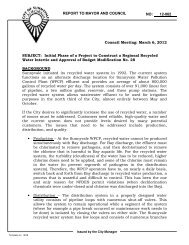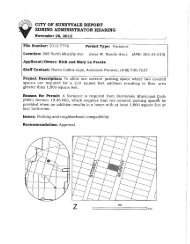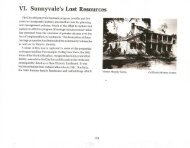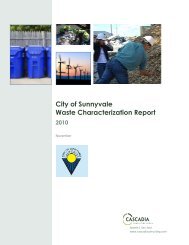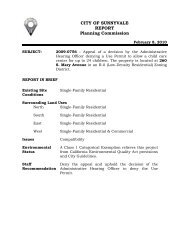Update to Green Building Progr - City of Sunnyvale - State of California
Update to Green Building Progr - City of Sunnyvale - State of California
Update to Green Building Progr - City of Sunnyvale - State of California
Create successful ePaper yourself
Turn your PDF publications into a flip-book with our unique Google optimized e-Paper software.
2012-7019 – <strong>Update</strong> <strong>to</strong> <strong>Green</strong> <strong>Building</strong> <strong>Progr</strong>am (Residential and Public <strong>Building</strong>s)<br />
April 24, 2012<br />
Page 10 <strong>of</strong> 16<br />
Requirements for Verification <strong>of</strong> Residential <strong>Green</strong> <strong>Building</strong> Items<br />
An important fac<strong>to</strong>r in assuring the green building items are met is the<br />
verification that items are included in the construction documents and are<br />
installed properly. As part <strong>of</strong> the original green building program, much <strong>of</strong> the<br />
verification was <strong>to</strong> be completed by <strong>City</strong> staff <strong>to</strong> reduce the cost and avoid a<br />
barrier for homeowners and developers in meeting the new standards.<br />
If a project takes advantage <strong>of</strong> an incentive, then verification by a qualified<br />
third party (a Build It <strong>Green</strong> certified <strong>Green</strong> Point Rater) is required. Similar <strong>to</strong><br />
the LEED requirements for non-residential construction, registration and<br />
certification from Build It <strong>Green</strong> is not required because the purpose <strong>of</strong> the<br />
program is <strong>to</strong> improve the green features included in construction projects. A<br />
few residential developers have chosen <strong>to</strong> submit their projects <strong>to</strong> Build It<br />
<strong>Green</strong> as a marketing <strong>to</strong>ol, but it does not appear <strong>to</strong> result in a greener<br />
building.<br />
Since the adoption <strong>of</strong> the green building program, the number <strong>of</strong> <strong>Green</strong> Point<br />
Raters has increased significantly and the cost <strong>of</strong> their services has decreased.<br />
Therefore, staff is recommending that all new construction be verified by a<br />
<strong>Green</strong> Point Rater.<br />
Incentive for Installing Electric Car Chargers in New Residential Construction<br />
In November 2011, as part <strong>of</strong> the study issue titled “Require Electric Car<br />
Chargers in New Residential Developments,” Council adopted standards for all<br />
new residential construction <strong>to</strong> require a minimum <strong>of</strong> 12.5% <strong>of</strong> parking spaces<br />
<strong>to</strong> be pre-wired with electric car chargers. At the same time, Council directed<br />
staff <strong>to</strong> study the option <strong>of</strong> providing incentives <strong>to</strong> the installation <strong>of</strong> electric car<br />
charging units in new residential developments.<br />
The current CAL<strong>Green</strong> and Build It <strong>Green</strong> programs do not require or provide<br />
points for electric car chargers. The LEED program (Leadership in Energy and<br />
Environmental Design) allows three points for the category titled “Alternative<br />
Transportation – Low-Emitting and Fuel-Efficient Vehicles.” There are four<br />
options available in order <strong>to</strong> obtain these three points; one option is <strong>to</strong> provide<br />
electric car charging units for a minimum <strong>of</strong> 3% <strong>of</strong> the parking spaces on site.<br />
Staff recommends including an incentive for new residential construction that<br />
follows the LEED standard. The recommended incentive would allow a new<br />
residential project <strong>to</strong> receive credit for three Build It <strong>Green</strong> points if electric car<br />
charging units were installed at a minimum <strong>of</strong> 3% <strong>of</strong> the parking spaces. For<br />
single-family/duplex projects this could be obtained by providing a charging<br />
unit in the garage. This would meet the minimum 3% requirement since a <strong>to</strong>tal<br />
<strong>of</strong> four parking spaces are required for each dwelling unit and one charging<br />
unit would be provided. For multi-family projects, charging units would need <strong>to</strong>


